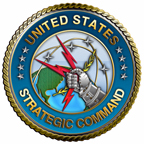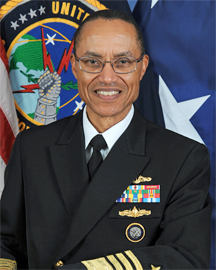
[SatNews] As concerns persist that sequestration spending cuts will continue to stress the human element of U.S. Strategic Command's capabilities, the United States must implement and maintain a defensible joint information environment, Stratcom's commander told the House Armed Services Committee.

Admiral Cecil D. Haney, Commander, USSTRATCOM
Navy Adm. Cecil D. Haney reported that the global security environment is getting more complex, dynamic and uncertain than at any time in recent history, as evidenced by ongoing events in Ukraine and North Korea. As a result, he said, Stratcom will execute a tailored deterrence and assurance plan that includes providing a safe, secure and effective nuclear deterrent force, partnering with other combatant commands, addressing space challenges, building cyberspace capability and capacity and preparing for uncertainty. The campaign, he said, is critical in addressing advances in state and non-state military capabilities across air, sea, land and space domains, as well as in cyberspace.
"The space domain is becoming ever more congested, contested and competitive, [and] worldwide cyber threats are growing in scale and sophistication," he said, adding that the proliferation of weapons and nuclear technologies also continues. "No region of the world is immune from potential chemical, biological, radiological, nuclear risk."
Terrorist threats also remain a source of significant ambiguity, and the threat of home-grown violent extremists remains a concern, the admiral emphasized. Against this dynamic and uncertain backdrop, Haney said, Stratcom's missions are to partner with other combatant commands to deter attack, detect strategic attack against the United States and its allies, and defeat those attacks if deterrence fails. "Our unified command plan assigned missions are strategic in nature, global in scope and intertwined with the capabilities of the joint force, the interagency and the whole of government," he added.
These attributes, Haney told the panel, require linkages and synergies at all levels to bring integrated capabilities to bear through synchronized planning, simultaneous execution of missions and coherent strategic communications. But trained, ready people are at the heart of the command's missions and priorities, Haney said, citing recent personal integrity concerns associated with the intercontinental ballistic missile force at Malmstrom Air Force Base, Montana.
"I fully support [Defense Secretary Chuck Hagel's] initiatives to assemble key Department of Defense stakeholders to fully assess and understand the implications of recent events and seek long-term systematic solutions that will maintain the trust and confidence in our nuclear enterprise," Haney said.
In addition to critical deterrence and assurance work, Stratcom is engaged in broader missions such as intelligence, surveillance and reconnaissance; missile defense; joint electronic warfare; global strike; and analysis and targeting.
"While these diverse activities are being synchronized and integrated by an outstanding team, none of this work ... could be accomplished without trained, ready, motivated people," the admiral said. "They remain our most precious resource and deserve our unwavering support."
Story by Amaani Lyle, American Forces Press Service.

